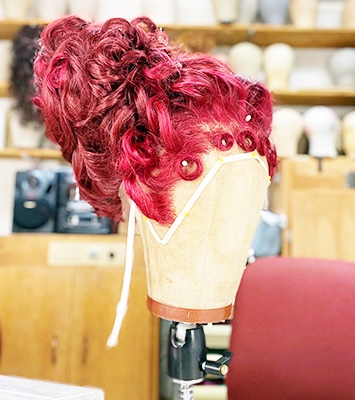Showcase Interview: Psh*tter! Hair & Makeup Coordinator

December 2020
Promenade Showcase + Gift Shop, while temporarily closed for safety considerations, highlights Krannert Center’s history, the students who study here, the productions we create, and the work that comes out of our shops, classrooms, and theatres. Despite the current closure, the Center’s educational mission continues featuring elements of new works that are created in our classrooms and shops. To learn about the work and art involved in creating specially styled wigs for Illinois Theatre’s December 3-12 virtual production of Pshitter! A Drinking Song for the Year of Our Lord 2020, we talked with Hair and Makeup Coordinator Colin Grice.
Q: How many wigs did you build for Psh*tter!?
A: Only one wig was fronted for Psh*tter! this time around, which was Queen Wictoria’s done by Lisa Lillig. I built the support structure that was later attached to the base to create the final shape of the style.
Q: What is your favorite wig you worked on?
A: My favorite wig to work on was Queen Wictoria’s. There were challenges that came with it, but being able to work out those problems was part of the fun. Having built a support structure in the past gave me an upper hand in how to successfully complete the look that the designer was going for.
Q: How long does it take to build a wig?
A: The process of building a wig can vary somewhat depending on what all goes into the final product. Fronting a wig, which involves tying hair strands into the lace front of a wig to create a realistic hairline, can take on average upwards of 15 hours to complete.
Q: How long does it take to style your favorite wig?
A: For Queen Wictoria, the style in itself took two to three hours to complete, based on prepping the curls and figuring out how many extra wefts of hair were needed to create texture and dimension. The building of the structure took a bit longer because of having to use trial and error to get the overall desired look.
Q: What got you interested in hair and makeup?
A: I started doing hair at a very young age. I believe that’s what influenced my desire to do hair and makeup professionally. I was exposed to natural/textured hair fairly early by my niece, and I learned valuable techniques to preserve her natural hair texture. I really got more into wig styling as an undergrad because of my interest in the historical significance hair has on societies.
Makeup-wise, I’ve always had a fixation on how artists use it to create these visual masterpieces. I became more interested in makeup during high school, but it wasn’t until undergrad that I started using it as an art form.
Q: What was your favorite makeup look for Psh*tter! and why?
A: My favorite makeup look that I personally worked on would be Daddy Ubu’s. The chance to work with a character who has substance abuse problems and being able to showcase that through makeup is always interesting to me. The illusion of track marks and bruising on the body is fun to create, especially if it looks realistic. It adds depth to the character, and I love that I’m able to help the performer feel more into the character that way.
Q: What was the most challenging makeup look for Psh*tter! and why?
A: The makeup in itself wasn’t entirely challenging; it was more the need to maintain continuity throughout the filming process. It was figuring out—especially during COVID-19—how to create a look while also maintaining restrictive guidelines.
Q: How did you get the height of the Lady Macduff and Queen Wictoria wigs?
A: For Queen Wictoria’s wig, I initially curled the hair to create structure and volume. This allowed for the support structure that was built into the base of the wig to be fully covered and allow for a more realistic look. By wrapping the hair around the structure, it allowed for more height and volume to be established.
For Lady Macduff’s wig, the challenge was to mimic a 1980s bouffant but still have enough hair all around to keep the wig’s overall fullness. During filming, additional tracks of hair were needed to be handstitched back into the base of the wig to create that overall big hair look. The bouffant needed many layers of teasing to create the overall texture of the desired look.
Queen Wictoria
Costume Designer: Melissa Hall Reynolds
Director: Lisa Dixon
Hair & Makeup Supervisor: Lisa Lillig
Hair & Makeup Coordinator: Colin Grice
Crafts Supervisor/Technician: Tracee Bear
Puppet Head Piece
Costume Design: Melissa Hall Reynolds
Director: Lisa Dixon
Crafts Supervisor: William Sturman
Crafts Technician: Tracee Bear
Puppet Baby Heads
Costume Designer: Melissa Hall Reynolds
Director: Lisa Dixon
Crafts Supervisor/Technician: William Sturman
Mama Ubu
Costume Designer: Melissa Hall Reynolds
Director: Lisa Dixon
Crafts Supervisor/Technician: Tracee Bear
Daddy Ubu
Costume Designer: Melissa Hall Reynolds
Director: Lisa Dixon
Crafts Supervisor/Technician: Tracee Bear




